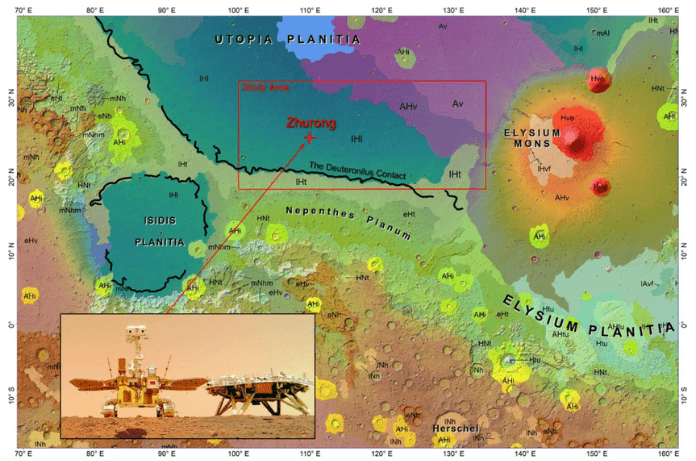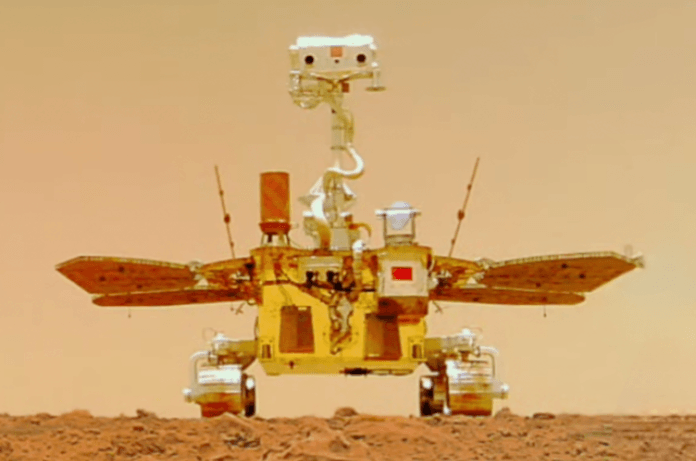Recent discoveries from China’s Zhurong rover have thrown new light on the ancient past of Mars, suggesting that the planet may have once hosted a vast ocean. This revelation challenges our previous assumptions about Mars as a cold, dry world and hints at the possibility that it could have supported microbial life in its distant past. With the help of data from Zhurong and various orbiting spacecraft, scientists have uncovered geological features on Mars that closely resemble Earth’s coastlines, sediment channels, mud volcanoes, and troughs, which point to the existence of a large body of water in Mars’ ancient history. Zhurong is named after a mythical Chinese fire god.
Evidence of Mars’ Ancient Ocean
The study, published in Scientific Reports, draws on data from China’s Tianwen-1 orbiter, NASA’s Mars Reconnaissance Orbiter and the Zhurong rover to suggest that Mars once had a significant body of water. An Ocean that may have been large enough to shape the Red planet’s surface. These findings include features such as sediment-filled channels and mud volcanoes, which have long been linked to the presence of liquid water on Earth. The evidence not only suggests the ocean existed, but that Mars might have once been much warmer, potentially capable of supporting life.

“We estimate that Utopia Planitia flooded around 3.68 billion years ago,” says Bo Wu, lead author of the study and Director of Planetary Remote Sensing Laboratory, The Hong Kong Polytechnic University, Kowloon, Hong Kong, People’s Republic of China. “The ocean likely froze over in a short geological period, disappearing by around 3.42 billion years ago.”
Mars’ Evolutionary History: Warm and Wet to Cold and Dry
While today’s Mars is a cold, dry planet with a thin atmosphere, scientists believe that it may have once had a much more hospitable environment. The new study suggests that Mars had a warm climate at one point in its history, with liquid water on the surface conditions that could have been favorable for microbial life to thrive. The discovery of ancient coastlines, combined with the identification of troughs and sediment channels, offers strong evidence that Mars may have had both shallow and deep marine environments in its distant past.
What Zhurong Tells Us About Mars’ Water History
Zhurong, the Chinese rover named after a mythical fire god, has been instrumental in these discoveries. Launched in May 2021, it has far exceeded its original three-month mission, contributing valuable data before going into hibernation due to dust accumulation in May 2022. Despite this, researchers continue to explore the Red Planet’s water history, including exciting new data from NASA’s InSight lander, which suggests there could be a massive liquid water reservoir deep beneath the Martian surface.
Could Mars Have Supported Life?
These findings raise the intriguing possibility that Mars might have once been a more Earth-like planet, with a climate and environment capable of sustaining life. While the ocean seems to have disappeared billions of years ago, its legacy may still be preserved in the Martian landscape. If Mars once had such an environment, it could mean that the planet was once habitable at least for simple microbial life. This discovery has significant implications for the search for life beyond Earth, as it suggests that the conditions we often associate with habitability may not be confined to our home planet.
A Glimpse Into Mars’ Mysterious Past
The evidence that Mars may have once hosted an ocean offers a fascinating glimpse into the planet’s past and opens up new possibilities for future exploration. As researchers continue to study the surface and interior of Mars, the idea that the planet once had the right conditions for life is becoming harder to dismiss. Its data is just the beginning of a deeper exploration of Mars’ water history and its potential to support life. As technology and research continue to evolve, we may be closer than ever to unraveling the mysteries of the Red Planet’s ancient past.

